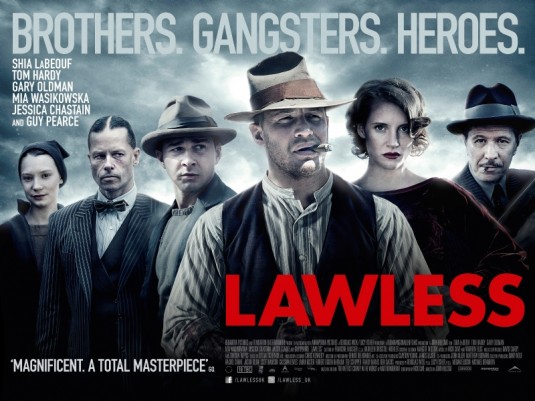 The goal of most of today’s movies is to transport an audience elsewhere. Director John Hillcoat achieves this better than most in Lawless, starring Shia LaBeouf, Tom Hardy, Jessica Chastain, and Guy Pearce. Hillcoat strategically uses shots of Appalachian landscapes and rustic folk music to put the audience in 1920s Virginia. There’s something about the roaring 20s that makes one want to put on a tux and do the Charleston with a fistful of moonshine. Put moonshine in the midst of Prohibition, mix it with some good ol’ boys, a pretty girl or two, gangsters, and a few tommy guns, and you’ve got the foundation of Lawless—but there is much more to the film than that. Hillcoat uses Lawless to explore how brotherhood overcomes any obstacles, how manhood is filled with emotion, and the justification of revenge. These three themes come to together to form a heartfelt, albeit bloody story.
The goal of most of today’s movies is to transport an audience elsewhere. Director John Hillcoat achieves this better than most in Lawless, starring Shia LaBeouf, Tom Hardy, Jessica Chastain, and Guy Pearce. Hillcoat strategically uses shots of Appalachian landscapes and rustic folk music to put the audience in 1920s Virginia. There’s something about the roaring 20s that makes one want to put on a tux and do the Charleston with a fistful of moonshine. Put moonshine in the midst of Prohibition, mix it with some good ol’ boys, a pretty girl or two, gangsters, and a few tommy guns, and you’ve got the foundation of Lawless—but there is much more to the film than that. Hillcoat uses Lawless to explore how brotherhood overcomes any obstacles, how manhood is filled with emotion, and the justification of revenge. These three themes come to together to form a heartfelt, albeit bloody story.
The film portrays these themes quite well. The three Bondurant brothers that the story revolves around cover basically every male stereotype. There’s a selfish overly-ambitious one, a quiet emotionless one, and a loud impulsive one. The three encounter conflict after conflict, but the fact that they are brothers trumps each problem. Hillcoat tries diligently to prove the power of family, and he succeeds. He uses exaggerated situations to explore brotherhood, but each is believable.
The selfish brother, Jack, lives out an archetypal coming-of-age tale. He jumps at the chance to take his family’s alcohol smuggling business into his own hands. The plot that ensues delves deep into Jack’s struggle to grow into his brothers’ shoes. The film flits back and forth between Jack’s innocent encounters with love and a bloody reality that surrounds him. Heavy emotions permeate Jack’s character. Emotions and manhood do not usually go hand in hand, but Hillcoat believes they should.
The film’s strong emphasis on brotherhood and manhood justifies the brothers’ longing for revenge. Most of the story’s conflict is based on this longing. Normally, a film with this much vengeance becomes predictable and disappointing. Everyone knows that revenge never turns out well. But in Lawless, the brothers’ struggles are shown in a way that makes it nearly impossible to not want vengeance right alongside the characters.
The acting in Lawless is, simply put, well done. LeBeouf portrays his usual sarcastic character, but he adds an Appalachian accent and gives a remarkable performance in a few key dramatic scenes. Hardy gives a rather flat performance, but for his character, it works. Chastain, like LaBeouf, shone brightly in her dramatic scenes. The film’s antagonist, played by Pearce, has one of the best laughs in show business. It is high-pitched, slimy, but uncomfortably loveable — perfect for a well-dressed bad guy. Although the acting was well done, it’s the soundtrack that should be commended. A toe-tapping compilation of folk songs by The Bootleggers and Ralph Stanley is used to keep the film’s energy high. It’s filled with fiddle, banjo, and some old-school harmonies. The film’s dramatic nature leads to a few overly dramatic scenes that could leave an audience giggling, but the music counteracts this. It fills silences and manipulates thoughts to guide the audience back into a believable 1920s Virginia.
Overall, Lawless is worth seeing. If not for the underlying exploration of manhood, see it for the action, drama, and good music.

